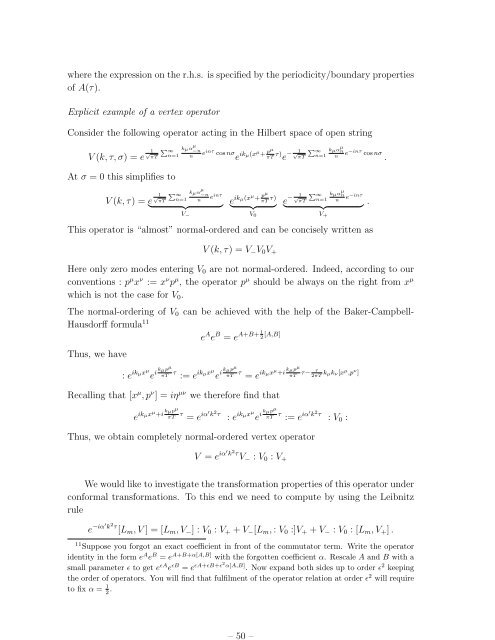Lectures on String Theory
Lectures on String Theory
Lectures on String Theory
Create successful ePaper yourself
Turn your PDF publications into a flip-book with our unique Google optimized e-Paper software.
where the expressi<strong>on</strong> <strong>on</strong> the r.h.s. is specified by the periodicity/boundary properties<br />
of A(τ).<br />
Explicit example of a vertex operator<br />
C<strong>on</strong>sider the following operator acting in the Hilbert space of open string<br />
√<br />
V (k, τ, σ) = e 1 P ∞<br />
kµα µ −n<br />
πT n=1 e n inτ cos nσ e ik µ(x µ + pµ<br />
πT τ) e − √ 1 P ∞ kµα µ n<br />
πT n=1 n e−inτ cos nσ .<br />
At σ = 0 this simplifies to<br />
V (k, τ) = e 1 √<br />
πT<br />
P ∞<br />
n=1<br />
kµα µ −n<br />
e n<br />
inτ<br />
e ikµ(xµ + pµ<br />
πT<br />
} {{ τ)<br />
} e − 1 P<br />
√ ∞ kµα µ n<br />
πT n=1 n<br />
} {{ e−inτ<br />
} .<br />
V − V 0 V +<br />
} {{ }<br />
This operator is “almost” normal-ordered and can be c<strong>on</strong>cisely written as<br />
V (k, τ) = V − V 0 V +<br />
Here <strong>on</strong>ly zero modes entering V 0 are not normal-ordered. Indeed, according to our<br />
c<strong>on</strong>venti<strong>on</strong>s : p µ x ν := x ν p µ , the operator p µ should be always <strong>on</strong> the right from x µ<br />
which is not the case for V 0 .<br />
The normal-ordering of V 0 can be achieved with the help of the Baker-Campbell-<br />
Hausdorff formula 11<br />
Thus, we have<br />
: e ik µx µ e i k µp µ<br />
πT τ := e ik µx µ e i k µp µ<br />
e A e B = e A+B+ 1 2 [A,B]<br />
πT τ = e ik µx µ +i k µp µ<br />
πT<br />
Recalling that [x µ , p ν ] = iη µν we therefore find that<br />
τ− τ<br />
2πT k µk ν [x µ ,p ν ]<br />
e ik µx µ +i k µp µ<br />
πT τ = e iα′ k 2 τ<br />
: e ik µx µ e i k µp µ<br />
πT τ := e iα′ k 2 τ<br />
: V 0 :<br />
Thus, we obtain completely normal-ordered vertex operator<br />
V = e iα′ k 2τ V − : V 0 : V +<br />
We would like to investigate the transformati<strong>on</strong> properties of this operator under<br />
c<strong>on</strong>formal transformati<strong>on</strong>s. To this end we need to compute by using the Leibnitz<br />
rule<br />
e −iα′ k 2τ [L m , V ] = [L m , V − ] : V 0 : V + + V − [L m , : V 0 :]V + + V − : V 0 : [L m , V + ] .<br />
11 Suppose you forgot an exact coefficient in fr<strong>on</strong>t of the commutator term. Write the operator<br />
identity in the form e A e B = e A+B+α[A,B] with the forgotten coefficient α. Rescale A and B with a<br />
small parameter ɛ to get e ɛA e ɛB = e ɛA+ɛB+ɛ2 α[A,B] . Now expand both sides up to order ɛ 2 keeping<br />
the order of operators. You will find that fulfilment of the operator relati<strong>on</strong> at order ɛ 2 will require<br />
to fix α = 1 2 . – 50 –

















